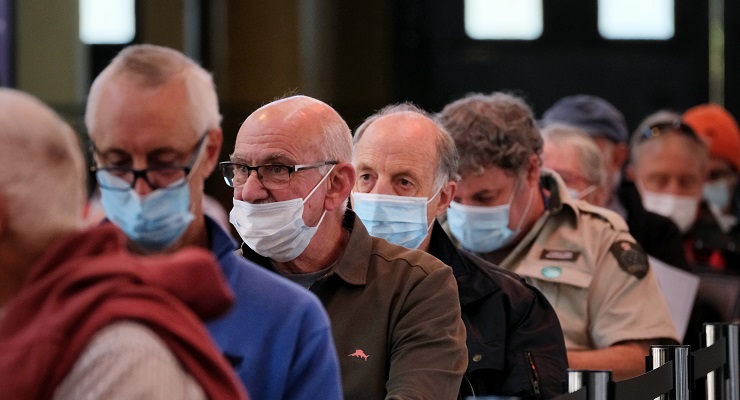
The World Health Organization (WHO) says government leaders need to pledge an extra US$50 billion to help end the coronavirus pandemic. The cash could be used to boost manufacturing and distribution of medical supplies and vaccines — and have 40% of the world’s population vaccinated by the end of 2021. Prime Minister Scott Morrison announced today that Australia will donate an extra $50 million to the Gavi vaccine alliance’s COVAX facility for vaccine equity.
Australia’s current rollout pace means it is not likely to meet the WHO’s new goal. Despite throwing $7.2 billion at the rollout — including a tidy $155.9 million given directly to private contractors — only 4.5 million doses have made it into Australian arms, with just 17% of the adult population having received their first jab, and just 2% fully vaccinated.
And as was revealed in Senate estimates this week, just 1.6% of people living in residential disability accommodation — one of the highest priority groups — have been fully vaccinated.
More money, more problems?
The US$50 billion plea was made by heads of the International Monetary Fund, World Bank Group, WHO and World Trade Organization to finance a roadmap to “accelerate the equitable distribution of health tools to help end the pandemic”.
“By now it has become abundantly clear there will be no broad-based recovery without an end to the health crisis. Access to vaccination is key to both,” their statement said. It called for doses to be donated to developing countries along with improved trade to deliver raw supplies. Shortages of raw materials have hampered manufacturing in India, while factories around the world need to be upgraded to increase production capacity.
Dr Elizabeth Jackson, a senior lecturer in supply chain management and logistics at Curtin University, tells Crikey the issue did not appear to be a problem of funding, but of supply: “In supply chains, there’s a flow of three things: money, product and information.”
Jackson says global vaccine rollout issues stemmed from problems with side effects emerging, which led regulatory authorities to update advice and supply chain disruptions caused by extreme weather, raw material shortages and labour shortages amid COVID-19 outbreaks.
“I haven’t heard of a squeak from anybody from any government [or] from any community group that has said anything negative about the flow of finance,” she said.
Does Australia need help?
Similar problems around supply and information — but not funding — have hampered Australia’s rollout. Onshore manufacturer CSL is producing more than one million doses of AstraZeneca a week, and last week 352,170 doses of Pfizer were tested and released by the Therapeutic Goods Administration.
While vaccination rates have been ramping up, they’re still low, with about 610,000 doses administered a week. At the current trajectory, Australia’s adult population won’t be fully vaccinated until mid-2022. In fact, Australia’s current goals sit behind WHO’s goals for developing countries: Australia aims to have “a dose available to everyone who wants one by the end of the year”, Minister for Aged Care Services Richard Colbeck said in mid-May. The government stopped providing more specific timelines and goals in March.
Deakin University global governance expert associate professor Max Kelly tells Crikey that although those numbers might imply Australia is a charity case, WHO is unlikely to step in and help.
“Australia is more than capable of vaccinating our population, but the political will to address it is not there,” she said. “In terms of taking responsibility, the federal government has fallen way short.”
What about all those vaccine deals?
The WHO has criticised Australia, the United States, Canada, the EU, New Zealand and the UK for securing four times the amount of vaccines needed for their populations while other countries are further down the waiting list for doses.
But Kelly says it’s a bit of a moot point.
“It becomes almost meaningless to say that we’ve got enough … to vaccinate Australia four times over,” she said. “Those are future promises and doses that are probably not produced yet.”
Dr Jane Williams, a health ethics expert at University of Sydney, tells Crikey that what Australia does with excess doses is crucial.
“Hedging by having options on different vaccines was not necessarily an issue, but buying them all and hanging on to them in excess of what is needed in the short- to medium-term is harmful for countries who can’t get or afford any,” she said.
Should Australia be stockpiling vaccines? Let us know your thoughts by writing to letters@crikey.com.au. Please include your full name to be considered for publication in Crikey’s Your Say section.








It’s all a joke. The government set aside $288 to get me vaccinated, I’m in phase 1b, but might as well be in phase 42z. Making an appointment is impossible because the secret code thingo doesn’t work. I keep trying, and emailing them, and they (it?) send me new codes which don’t work either. So tell me why I should have a phase, or a code? I don’t want them, I want a VACCINE!
It’s a joke.
Your poor bugger. I had my first AZ jab on May 17th at my GP in Perth, the first day I could have it as somebody over 60. I booked it two weeks earlier when I had my flu jab. I’m booked to have my second AZ the first week of August. I hope the federal government won’t have buggered up supply by that time.
Um, the WHO is actually asking governments to pledge $50 billion, not $50 million. $50 million is such small change, it wouldn’t have much effect. The typos are a little annoying.
What’s a realistic logistics timeframe of vaccinating how many 6/7/8 ? billions ?
Incompetence begins at home?
Or is it corruption?
Incompetence and corruption are not mutually exclusive.